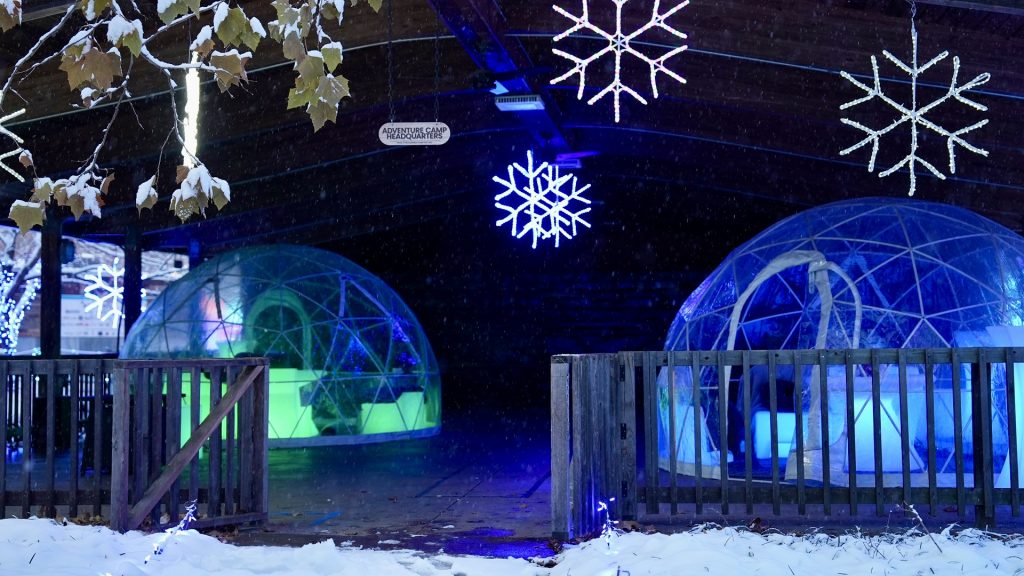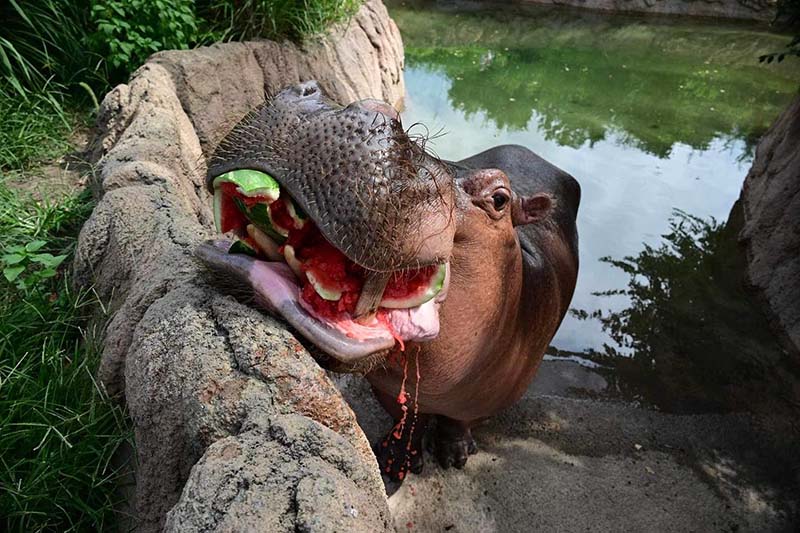Topeka Zoo and Rainforests
Written by Shari LaRue, Docent
Rainforests are Earth’s oldest living ecosystems, with some surviving in their present form for at least 70 million years. They are incredibly diverse and complex, home to more than half of the world’s plant and animal species—even though they cover just 6% of Earth’s surface. This makes rainforests dense with plants and animals. A 4 square mile patch can contain as many as 1,500 flowering plants, 750 species of trees, 400 species of birds and 150 species of butterflies. The Amazon Tropical Rainforest is the largest with an estimated 40,000 plant species,1,300 bird species, 3,000 types of fish, 427 species of mammals, and 2.5 million different insects.
Rainforests thrive on every continent except Antarctica. The largest rainforests on Earth surround the Amazon River in South America and the Congo River in Africa. The tropical islands of Southeast Asia and parts of Australia support dense rainforest habitats. Even the cool evergreen forests of North America’s Pacific Northwest and Northern Europe are a type of rainforest (temperate).
Rainforests rich biodiversity is incredibly important to our well-being and the well-being of our planet. Rainforests help regulate our climate and provide us with everyday products such as chocolate, nuts, bananas, cinnamon, pepper, ginger, coffee, vanilla and many modern-day medicines. Seventy percent of the medicines used in cancer treatments come from the rainforest.
Rainforests produce about 20% of our oxygen and store huge amounts of carbon dioxide. They are vital in controlling greenhouse gas emissions. Massive amounts of solar radiation are absorbed by the rainforest and this helps to regulate temperatures around the world.
Since more than 50% of precipitation striking a rainforest is returned to the atmosphere through evaporation, this helps to regulate rainfall not just in the rainforest, but around the world. Most rainforests will experience between 80 to 200 inches of rain each year.
Our rainforests are disappearing at an alarmingly rate, largely due to human development. Once covering 14% of land on Earth, rainforests now make up only 6%.Today, unsustainable industrial and agricultural development has severely degraded the health of rainforests and 100 acres of rainforest are cleared every minute for industrial purposes. It will take everyone, citizens, governments, organizations, and conservation groups working together to protect rainforests from unsustainable palm oil plantations, logging and other human development.
Rainforest Structure
Most rainforests are structured in four layers: emergent, canopy, understory, and forest floor. Each layer has unique characteristics based on differing levels of water, sunlight, and air circulation. While each layer is distinct, the plants and animals in one layer often depend upon those in the others.
Emergent Layer
The top layer of the rainforest is the emergent layer. Here, trees as tall as 200 feet grow up into the sky. These trees have sparse growth on their trunks but spread wide as they reach the uppermost layer. Small, waxy leaves help trees in the emergent layer retain water during long droughts or dry seasons. Lightweight seeds are carried away from the parent plant by strong winds.
In the Amazon rainforest, these towering trees include the Brazil nut tree and the kapok tree, both deciduous trees. The Brazil nut tree, a vulnerable species, can live up to 1,000 years in undisturbed rainforest habitats.
Animals that fly or glide will often move about the emergent layer. They include birds, bats, gliders and butterflies. Bats are the most diverse mammal species in most tropical rainforests, and they regularly fly throughout the emergent, canopy, and understory layers.
Canopy Layer
Beneath the emergent layer is the canopy, a deep layer of vegetation roughly 20 feet thick. The canopy’s dense network of leaves and branches forms a roof over the two remaining layers, often blocking winds, rainfall, and sunlight. This helps to create a humid, still, and dark environment below. Trees have adapted to this damp environment by producing glossy leaves with pointed tips that repel water.
Canopy plants, lacking wind like the emergent layer trees, encase their seeds in fruit. Fruit entices animals to feed and then deposit seeds on the forest floor as droppings. Fig trees, common throughout most of the world’s tropical rainforests, may be the most familiar fruit tree in the canopy.
More animals live in the canopy layer because of the bounty of fruits. The dense vegetation dulls sound, so many animals of the canopy have shrill and frequent vocalization. In the Amazon rainforest you will find scarlet macaws, toucans, spider and howler monkeys and the two-toed sloth in the canopy. You will also find thousands of insect species.
Understory Layer
Located feet below the canopy, the understory is dark, quiet and very humid. Plants here, such as palms and philodendrons, grow with large leaves to catch the minimal sunlight reaching beyond the dense canopy.
The reason some animals call the understory home is to take advantage of the dimly lit environment for camouflage. The spots on a jaguar of Central and South America, may be mistaken for leaves or flecks of sunlight. Bats, birds, insects and amphibians all live in the understory. It provides more open space for those that fly and the constant dampness helps frogs and lizards keep their skin moist.
Some of the most endangered species live in Central Africa’s tropical rainforest. They include forest elephants, pythons, antelopes, and gorillas.
Forest Floor Layer
Because the forest floor is so dark, here is where you will find the decomposers. Termites, slugs, scorpions, worms, and fungi live in this darkness and decompose the organic materials that fall to the ground. Their breaking down these materials helps keep the forest healthy by providing nutrients to all the plants.
On the forest floor you will find wild pigs, armadillos, and anteaters eating the insects that function as decomposers. Because you can find rodents and other small animals on the forest floor, you will also find larger predators like leopards that prey upon the smaller animals.
Rivers that run through some tropical rainforests provide homes for many other creatures. For example, in the Amazon River, is home to the pink river dolphin. They are one of the few freshwater dolphin species in the world. The Amazon is also home to black caimans, the Congo River is home to the caimans’ cousin, the Nile crocodile.
Topeka’s tropical oasis
The Topeka Zoo built the largest of its kind rainforest in 1974. The award winning tropical rainforest was developed to provide guests with an Amazonian experience. Today we have species from not only South America, but from other tropical rainforest areas such as Africa. It was developed to maintain temperatures of 78-82-degree Fahrenheit, although it feels warmer than that because of the 80-100% humidity. The irrigation system runs about every other day in the summer and about once a week in the winter.
Our rainforest is 100 feet in diameter with concrete walls that are 10 feet high. The geodesic dome has an aluminum frame with 240 triangular panels of clear acrylic that is 31 feet tall at the midpoint. These panels allow 85% solar energy and 92% of the natural light through to the plants and animals inside.
The water fall inside the rainforest is 17 feet tall and 8 feet wide. It was built to run 450 gallons/minute into the lake below. In 1974 the waterfall was named Bates Falls, after Henry Bates, who explored the Amazon River basin and Marston Bates a noted naturalist who contributed to present day knowledge on the tropics. The lake was named Lake Yagua after one of the Indian tribes of the Amazon, the Yaguas.
Just as in any rainforest, you will experience the hot, humid environment full of life. As you walk through, take time to look for the many bird species that live in the different layers of the rainforest. At the forest floor level, you will see the beautiful colors of iridescent greens and greenish blue of the Nicobar pigeon. They are a larger pigeon and are a relative of the extinct Dodo bird. You will also see our pink colored Roseate Spoonbills (named after their large spoon shaped beaks), Black Crakes, Tragopans (a type of pheasant) and numerous ducks on the ponds.
In the canopy of the rainforest, you will see the beautiful Violet Turaco with its violet-colored plumage, a thick orange bill and yellow forehead. You will also spot the critically endangered Bali Mynah that are white with a beautiful crest of feathers on the top of their heads. Here too you will see the Taveta Golden Weavers busy making their nests in the upper levels of the canopy. They are from Africa (Kenya and Tanzania area) and are smaller, industrious yellow birds. Another larger bird in the canopy, usually trying to make a big nest is the Hammerkop. It is a medium size bird with brown feathers. They build huge nests that unfortunately become a haven for cockroaches, so the keepers work hard to undo the nest building. These two birds are very interactive with the keepers and have been named Boris and Natasha.
Mammals of the upper most reaches of the rainforest, and often seen hanging from the dome are some of the largest bats in the world, the Indian Flying Fox. Named because they have a face that resembles a fox, they are not birds, but are mammals just like us humans. They eat fruits and spit out the seeds, helping to replant fruiting trees in the wild. Also, you will need to look hard to see Jackie, our Hoffmann’s two-toed sloth. Sometimes she can be found resting in the very top of the dome. Otherwise, finding her in the canopy can be a challenge.



